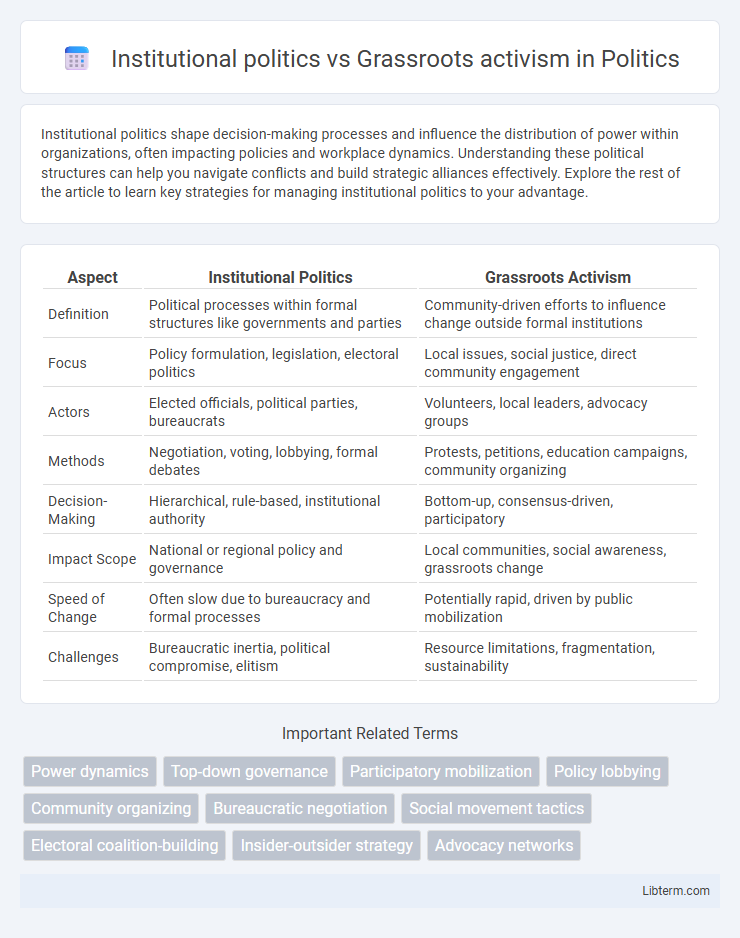Institutional politics shape decision-making processes and influence the distribution of power within organizations, often impacting policies and workplace dynamics. Understanding these political structures can help you navigate conflicts and build strategic alliances effectively. Explore the rest of the article to learn key strategies for managing institutional politics to your advantage.
Table of Comparison
| Aspect | Institutional Politics | Grassroots Activism |
|---|---|---|
| Definition | Political processes within formal structures like governments and parties | Community-driven efforts to influence change outside formal institutions |
| Focus | Policy formulation, legislation, electoral politics | Local issues, social justice, direct community engagement |
| Actors | Elected officials, political parties, bureaucrats | Volunteers, local leaders, advocacy groups |
| Methods | Negotiation, voting, lobbying, formal debates | Protests, petitions, education campaigns, community organizing |
| Decision-Making | Hierarchical, rule-based, institutional authority | Bottom-up, consensus-driven, participatory |
| Impact Scope | National or regional policy and governance | Local communities, social awareness, grassroots change |
| Speed of Change | Often slow due to bureaucracy and formal processes | Potentially rapid, driven by public mobilization |
| Challenges | Bureaucratic inertia, political compromise, elitism | Resource limitations, fragmentation, sustainability |
Understanding Institutional Politics: Definition and Scope
Institutional politics involves formal structures and processes within established organizations such as governments, political parties, and corporations, where power is exercised through official channels and decision-making bodies. It encompasses policy formulation, legislative activities, and administrative functions aimed at maintaining order and implementing laws. Understanding its scope reveals how institutional politics shapes public governance and influences societal norms through regulated mechanisms.
What is Grassroots Activism? Key Characteristics
Grassroots activism involves community-led efforts aimed at creating social or political change through collective action at the local level. Key characteristics include participatory decision-making, decentralization of power, and mobilization of ordinary individuals rather than relying on established institutions or elite leadership. This approach emphasizes direct engagement, building community solidarity, and leveraging local knowledge to influence broader policy and societal transformation.
Historical Perspectives: Institutional Politics vs Grassroots Activism
Historical perspectives reveal that institutional politics have long been characterized by structured decision-making within formal organizations, such as political parties and governments, shaping policy through established channels. Grassroots activism, emerging prominently during social movements of the 20th century, relies on community-based mobilization to challenge existing power structures and influence change from the ground up. Key historical examples include the Civil Rights Movement in the United States, where grassroots activism pressured institutional politics to enact landmark legislation like the Civil Rights Act of 1964.
Power Dynamics in Institutional Politics
Institutional politics revolves around power dynamics established through formal structures and hierarchies, where decision-making authority is centralized among elected officials, bureaucrats, and lobbyists. Control over policy agendas, resource allocation, and legislative processes enables institutions to maintain dominance and influence over public governance. Grassroots activism, by contrast, seeks to challenge this concentrated power by mobilizing community participation and advocating for bottom-up change outside traditional political frameworks.
Mobilizing Communities: The Core of Grassroots Movements
Mobilizing communities lies at the heart of grassroots activism, where localized efforts harness collective power to drive social change. Unlike institutional politics, which often navigates bureaucratic channels, grassroots movements engage directly with affected populations, fostering genuine participation and empowerment. Effective community mobilization builds trust, amplifies marginalized voices, and creates sustained momentum essential for transformative impact.
Strengths and Limitations of Institutional Politics
Institutional politics offers structured decision-making processes and access to legislative power, enabling policy changes through formal channels and sustained governance. However, it often faces bureaucratic inertia, gatekeeping by established elites, and slower responsiveness to urgent social issues compared to grassroots activism. The reliance on negotiation and compromise can dilute radical demands, limiting the scope of transformative change.
Advantages and Challenges of Grassroots Activism
Grassroots activism offers distinct advantages such as fostering genuine community engagement, mobilizing local resources effectively, and creating pressure from the bottom up for social or political change. Challenges include limited access to formal power structures, resource constraints, and difficulties in sustaining long-term momentum. Despite these hurdles, grassroots movements often drive culturally resonant initiatives that institutional politics may overlook or underrepresent.
Case Studies: Successful Institutional and Grassroots Initiatives
The civil rights movement in the United States exemplifies successful grassroots activism through organizations like the NAACP and local protests such as the Montgomery Bus Boycott, demonstrating powerful community-driven change. On the institutional politics side, South Africa's negotiated transition from apartheid relied on formal political processes, including the African National Congress working within legal frameworks and international diplomacy to achieve democratic reforms. Both approaches highlight effective strategies where grassroots mobilization builds pressure and institutional politics formalizes policy change.
Collaboration or Conflict: When Institutions Meet Activists
Institutional politics often operates through formal channels, policy-making, and hierarchical decision-making, which can conflict with grassroots activism's decentralized, community-driven approach focused on immediate social change. Collaboration emerges when institutions adapt to incorporate activist input, leveraging grassroots momentum for policy reform and increased legitimacy. However, persistent tension arises from differing priorities and power imbalances, complicating efforts to bridge systemic authority with activist urgency.
The Future of Political Change: Integrating Both Approaches
Institutional politics offers structured pathways for policy reform through legislation and party systems, while grassroots activism mobilizes community-driven energy to challenge the status quo and raise public awareness. The future of political change lies in integrating formal political mechanisms with vibrant grassroots movements to create inclusive, responsive governance that reflects diverse societal needs. Collaborative efforts between elected officials and activist groups can amplify impact, ensuring sustainable progress and innovative solutions to complex social issues.
Institutional politics Infographic

 libterm.com
libterm.com